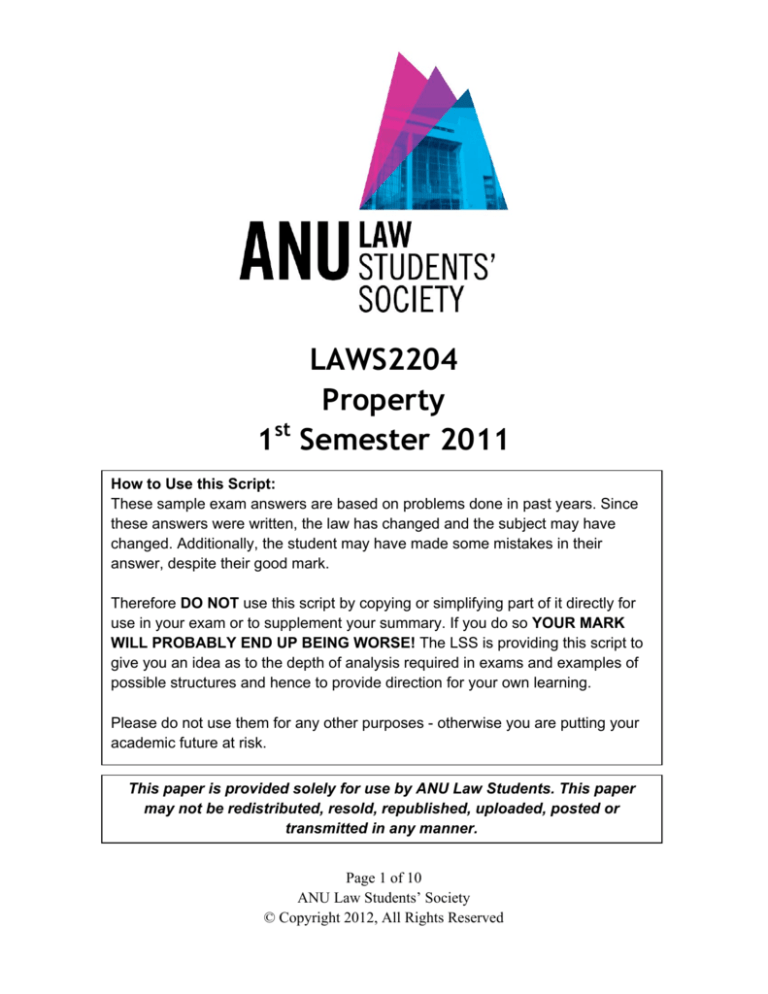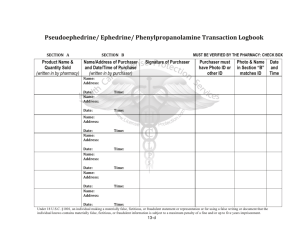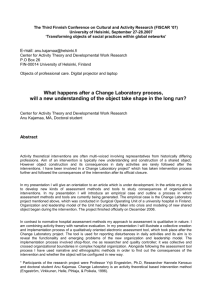
LAWS2204
Property
1st Semester 2011
How to Use this Script:
These sample exam answers are based on problems done in past years. Since
these answers were written, the law has changed and the subject may have
changed. Additionally, the student may have made some mistakes in their
answer, despite their good mark.
Therefore DO NOT use this script by copying or simplifying part of it directly for
use in your exam or to supplement your summary. If you do so YOUR MARK
WILL PROBABLY END UP BEING WORSE! The LSS is providing this script to
give you an idea as to the depth of analysis required in exams and examples of
possible structures and hence to provide direction for your own learning.
Please do not use them for any other purposes - otherwise you are putting your
academic future at risk.
This paper is provided solely for use by ANU Law Students. This paper
may not be redistributed, resold, republished, uploaded, posted or
transmitted in any manner.
Page 1 of 10
ANU Law Students’ Society
© Copyright 2012, All Rights Reserved
Question 1 (84/100)
Part (a)
Unless otherwise stated, all statutory provisions refer to the Conveyancing Act 1919 (NSW).
Carl (C) v Ben (B)
B had settled with Amy (A) and so is the legal fee simple holder. ü
C has an equitable interest in the shop arsing under a specifically enforceable contract and a
“mere equity” in estoppel. ü great
(a) Does C have an interest under a specifically enforceable contract (SEC)?
Bunny Industries would hold that C would have an equitable interest arising under a constructive
trust if the contract with A was specifically enforceable, ie the remedy of specific performance
would be available. ü
1. Is the contract valid?
There is certainty of subject matter (live there for the rest of your life), there is consideration
(work for next to nothing), but there is a family relationship between A and C as cousins. So I
query if there is a valid contract for no intention to create legal relations. More facts are needed
to ascertain A and C’s relation. Assume contract valid. ü could have looked @ strict v relaxed
test
2. Is the contract enforceable?
The contract is in writing and thus satisfied s 54A(1) CA. ü
3. Is the contract specifically enforceable?
There appears to be nothing that would prevent the contract from being specifically enforceable:
it is generally assumed that damages are not adequate remedy in relation to interests in land The
party seeking specific performance (C) is ready, willing and able to perform. In fact, he has
already performed by running A’s shop for “next to nothing”. There is no condition precedent
and no equitable bars to specific performance (delay, clean hands etc.) Thus P has a SEC. ü
In Tanwar, the High Court in obiter comments threw into doubt the Bunny analysis of the
interest a purchaser receives when they have a SEC. In particular, the High Court dislikes the
analogy of the constructive trust. The High Court did recognise that the purchaser receives an
equitable interest, but seems to prefer to talk about it as some sort of equitable lien. Accordingly,
we’ll continue to apply Bunny until the High Court next decides. ü excellent
Page 2 of 10
ANU Law Students’ Society
© Copyright 2012, All Rights Reserved
Thus, A holds the legal interest on constructive trust for C. On this basis C has an equitable
interest (full equitable interest) (assuming contract is valid). ü
Even if contract is invalid, C has a mere equity arising in estoppel. ü
Estoppel?
If an owner allows another to suffer detriment under an expectation created or encouraged by the
owner that he will have an interest in the land, then a mere equity will be recognised in that
person (Crabb). ü
Expectation of interest?
The letter identified probably a licence for life-long occupation like in Inwards. ü
Created by the owner?
Satisfied. A wrote the letter. ü
Detrimental reliance?
C worked presumably for 30 odd years and lived in the shop for that period of time, and for a
very small wage. His detriment is comparable to junior Mr Baker in Inwards who contributed to
building the house and lived in it for more than 30 years. The Court gave Baker the remedy of a
license. The facts are analogous to Inwards. Further, the detriment does not have to be directed
towards the land in question. ü
Therefore, C has a “mere equity” in the shop on the basis of estoppel (Inwards).
Thus, the priority dispute is between an earlier equitable interest (or a mere equity) against a later
legal interest. In both cases, the rule is the later legal interest will prevail if taken by a BFP
(Pilcher v Rawlins; Latec). ü
B was clearly a purchaser for value who has acted bona fide (apart from the notice issue). The
question thus becomes whether B has notice of the earlier equitable interest/“equity”. ü He has a
duty to investigate the chain of title and to inspect the shop. Both of these have been done. B
may be fixed with constructive notice of earlier interests that these inquiries and inspections
would have revealed: s 164(1)(a) CA. ü
Investigate title documents
Under s 53(1) CA, B has an obligation to search back to a good root of title at least 30 years old.
B will be fixed with notice of all documents with the chain of title back to that good root of title.
Assume that B’s inspections revealed no prior interests.
Page 3 of 10
ANU Law Students’ Society
© Copyright 2012, All Rights Reserved
Inspect the land
A purchaser will be deemed to have constructive [sic] of any interest in the land that an
inspection of the land itself would have revealed.
There may be an argument that the mere presence of signs of habitation is not sufficient to give
constructive notice. The shop was empty, dusty, boarded up and the power had been turned off
with no fresh food. However, the fact that personal belongings belonging to C plus A’s
acknowledgement that C had indeed lived there would put a reasonably prudent purchaser on
inquiry as to the belongings’ ownership and C’s actual interest in the shop. The prudent
purchaser would ask about the nature of C’s interest.
Since B failed to make further inquiries, he will be fixed with constructive notice of C’s prior
equitable interest/equity and so will be bound by that interest. ü
Therefore B has a legal fee simple subject to C’s license to live in the property as long as he
wished. ü
Delia (D) v B
B has a legal fee simple in the farm.
D prima facie has a legal interest in the property arising from adverse possession (AP).
Possession gives rise to rights (Asher; Mabo per Toohey). The paper title holder or prior
possessor has a right to bring an action to regain possession under s 20 of the Civil Procedure
Act. However, this right must be enforced within 12 years from the date on which a cause of
action first accrues to the title holder: s 27(2) Limitation Act (LA). For the cause of action to
accrue, the title holder must be out of possession and another person must be in possession: ss 28
and 38(1) LA. Prima facie the cause of action accrued to D 16 years ago. ü
1. Did D possess the land adverse to A?
To establish AP, D requires factual possession and an intention to possess (Pye). ü
Factual possession
There must be exclusive possession. What amounts to exclusive possession depends on the
circumstances, particularly the nature of the land and the manner in which land of that nature is
commonly used (Pye). ü
Page 4 of 10
ANU Law Students’ Society
© Copyright 2012, All Rights Reserved
The facts are analogous to Pye. In Pye, Graham had used the land for farming in the same way
he used his own neighbouring land. Further, he had excluded Pye by hedges and the lack of a key
to the padlock of the gate of the property. The court held that Pye had exclusive physical custody
and control. On the facts, D had demonstrated acts of ownership by mowing the pasture and
lived in the farm. I query if these acts are sufficient given the land is rural (eg, she should be
raising stock). Nonetheless, she effectively excluded A from the property by changing locks and
mending the fence ü
Intention to possess
An intention to possess requires an intention, in one’s own name and on one’s own benefit, to
exclude the world at large, including A (Pye). Similar to the discussion above, D’s occupation of
the premises coupled with changing locks and mending the fence indicated an intention to
exclude everyone including A. Note though it is not necessary to have an intention “to own”, just
to possess and I think D satisfies intention to possess. ü
2. Are there any “gaps” in possession?
AP must be continuous for the 12-year limitation period. A “gap” in time will stop time running
against the paper title holder and resets the clock back to zero: s 38(3) LA.
Because of the 5-year lease, A has consented to D’s possession in the first five years and so
times tarted to run only 11 years ago. ü
It is not an issue that D was away because she had not demonstrated an intention to give up her
rights to the land to the world at large (Moorhouse). ü
Thus, B has 1 more year to assert his title. B can assert his title either by physically retaking
possession (not recommended) or commencing court action under s 20 of the CPA
(recommended). Mere assertion of ownership is not sufficient. ü great
If not, B will lose priority dispute with D by virtue of the nemo dat rule (Whipps) – first in time
prevails (legal v legal).
Part (b): Is the armour a fixture?
1. The the [sic] contract deal with the issue?
No. ü
2. Degree of annexation
Page 5 of 10
ANU Law Students’ Society
© Copyright 2012, All Rights Reserved
The chattel is bolted to the wall, there is a presumption that it is a fixture (Belgrave). Onus of
rebutting the presumption lies with C by showing it was intended all along to continue a chattel.
ü
3. Purpose of annexation
The test for object is an objective one – the object is what a reasonable person would assume
from circumstances (Belgrave).
-
ease of removal; extent of removal
contrast Leigh v Taylor
Given alcove and bolt, probably cannot remove without damage to wall ü
-
nature of chattel
ornamental character, could not have been fixed more lightly (Leigh v Taylor)
-
nature of interest in realty held by attacher
Presumably by D – not an owner of fee simple, less likely intended to be fixture
-
subjective intention
owner of fee simple indicated it was fixture, merely one of factors taken into account –
not determinative.
Weighing up the factors, the initial presumption that the armour is a fixture is confirmed. So B
owns the armour.
great answers, well done!!
Page 6 of 10
ANU Law Students’ Society
© Copyright 2012, All Rights Reserved
Question 2 (72/100)
In this answer, RPA refers to the Real Property Act 1900 (NSW). Tks
Greg (G) v Fred (F) ü
F is the RP of the fee simple in Blackacre (B) ü
G probably has a licence for exclusive occupation of B. It is unregistered.
Is it a lease? Or estoppel? ü
G’s interest is not a lease because it is not of a certain duration, or a duration capable of being
rendered certain (Lace). It is not an implied periodic rent because G does not pay rent. It is
neither an equitable lease arising from a specifically enforceable contract because G has no
consideration (Walsh v Lonsdale). While Eve (E) may have encouraged an expectation in G of
an interest in B in her letter, G did not suffer any detriment on reliance of that expectation and
hence no estoppel. ü
Thus the dispute between G and F is between a registered and unregistered interest. ü
F is the RP of B and has immediate, indefeasible title (s 42(1) RPA, Frazer), subject to
exceptions. Prima facie, it is enforceable against G. ü
Fraud
Fraud is an express exception to indefeasibility (ss 42/43 RPA). ü Fraud requires some element
of actual dishonesty or moral turpitude on the part of the RP (Assets v Roihi). ü Mere notice
plus knowledge that registration will defeat an unregistered interest is not fraud for RPA
purposes (s 43 RPA; Wicks v Bennett). ü The fraudulent conduct in question has to relate to the
detraction or extinguishment of the unregistered interest, not mere general dishonesty (Grgic). ü
In Bahr v Nicolay, a contract of sale of land which contained an acknowledgement of Bahrs’
interest was held to be a promise to protect. Furthermore, in Loke Yew, a promise to protect was
held to be fraudulent if the purchaser had been dishonest at the time the promise was made as he
had no intention to satisfy the promise from the outset. üü
On the facts, F’s acknowledgement of G’s interest amounted to a promise to protect. While more
facts are needed to establish if F had been dishonest at the time he made the promise, the quick
speed at which he reneged on his promise, just 2 months after the sale was indicative that he had
not intended to keep the promise in the first place – which was a factor the court took into
consideration in Loke Yew. ü
Page 7 of 10
ANU Law Students’ Society
© Copyright 2012, All Rights Reserved
Mason CJ and Dawson J in obiter comments in Bahr noted that where a purchaser had made a
promise to protect, the subsequent breaking of the promise is dishonest and so fraudulent. On the
facts, F’s lease of B to T was a breaking of a promise to protect G’s license to exclusive
possession of B. But in the case, Mason CJ and Dawson are suggesting that the RP’s interest
may become defeasible even at post-registration – I query this approach as it undermines the
scheme of the RPA. You’re not the only one to do so. ü
In-personam obligation ü
A RP is subject to in personam obligation arising in law and equity (Frazer). ü
In Bahr, the court held that the mere fact of repudiating the promise was unconscionable ü when
Thompson was not in financial need. The court then imposed a constructive trust on Thompson
which the Bahrs could enforce against Nicolay as a matter of in personam obligation.
On the facts, it is unconscionable for F to have undertaken to be bound by G’s interest and
subsequently denies that interest. ü Further, F has no excusing factor (eg, financial need). What
about his son’s eviction? Thus, the court is likely to impose an in personam obligation on F in
the form of an unconscionability constructive trust. ü
Conclusion
Thus, while more facts are necessary to establish if F had been fraudulent at the time he
acknowledged G’s interests, it appears that F is bound in personam obligation to G and so is not
indefeasible. ü
Greg (G) v Tom (T)
T has an unregistered lease. Thus the priority dispute is between two competing unregistered
interest. ü
Section 43A RPA
Section 43A provides that T will gain indefeasibility before registration if he:
(a) has legal estate
(b) has a registrable dealing
(c) is dealing with an RP: IAC (Finance)
(a) Legal estate?
Page 8 of 10
ANU Law Students’ Society
© Copyright 2012, All Rights Reserved
The view of Taylor J in IAC (Finance) has prevailed (Meriton). Taylor J said that “legal estate”
means an old system legal estate. Hence T could defeat G’s interest if he is a BFP at settlement.
T was clearly a purchaser for value who has acted bona fide (apart from the notice issue). The
question becomes whether T has notice of G’s interest. On the facts, T had actual notice at
settlement. When T agreed with F on the lease, he was informed that “Greg lived in Blackacre
pursuant to an arrangement with Eve”. ü However, T may argue that F’s statement merely
informed him of a current occupation of B, and not necessarily an interest in B. However, given
that F mentioned G, the reasonably prudent purchaser would have made further inquiries of
someone other than the lessor. Thus T will be fixed with constructive notice (if not actual) of G’s
interest.
Thus T is not a BFP.
Registrable dealing?
No questions on the facts.
Dealing with RP?
Dealing with F who is the RP, thus satisfied.
Thus, T does not get the protection of s43A.
The inquiry then becomes between two unregistered interests. The rule is the first in time
prevails ü unless the equities are unequal ü (Rice; Heid). ü
1. Was there a causal connection between 1st in time’s conduct and 2nd in time acquiring the
interest in the mistaken belief that there was no prior interest?
Where the 1st interest holder fails to lodge a caveat, the 1st interest holder is likely to be
postponed (Abigail v Lapin).
In Butler v Fairclough, an agreement to execute a mortgage was held to be postponed because
the caveat had not been lodged before the purchaser had paid the purchase money and received
the transfer. On the facts, G did not lodge a caveat promptly upon receiving Eve’s letter. Thus,
his interest is likely to be postponed. ü
2. Is there any excusing factor for the 1st in time “ in fairness and justice”?
There is no standard conveyancing practice arising on the facts that the norm is not to caveat.
advice from lawyer?
Page 9 of 10
ANU Law Students’ Society
© Copyright 2012, All Rights Reserved
3. Did T know of the prior interest?
As discussed under the BFP rule, T had notice of the prior interest. Notice is generally irrelevant
to the question of priority between competing unregistered interests. However, notice is relevant
to deciding whether, in all the circumstances, the merits are equal. ü
So, in the case where the 1st interest holder has engaged in conduct which might otherwise have
been postponing, the 2nd interest holder cannot get priority if he had notice of the existence of
that earlier interest (Courtenay v Austin)
Hence G wins the priority dispute. ü
G v Sue (S)
S no longer has an interest in the land. ü
While she was the RP, she was indefeasible except for fraud.
While she had made a promise to protect, there is no indication on the facts that that was
dishonesty made (Loke Yew). In fact, her “pangs of conscience” had F acknowledge G’s
interest.
So G v S not an issue. ü
Page 10 of 10
ANU Law Students’ Society
© Copyright 2012, All Rights Reserved







